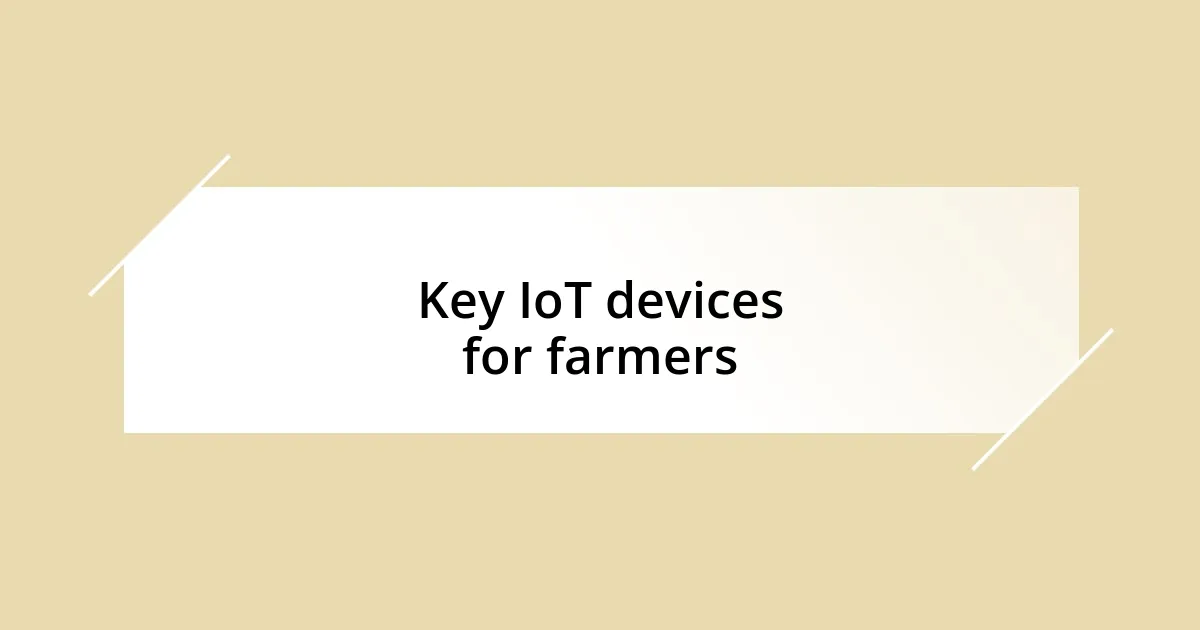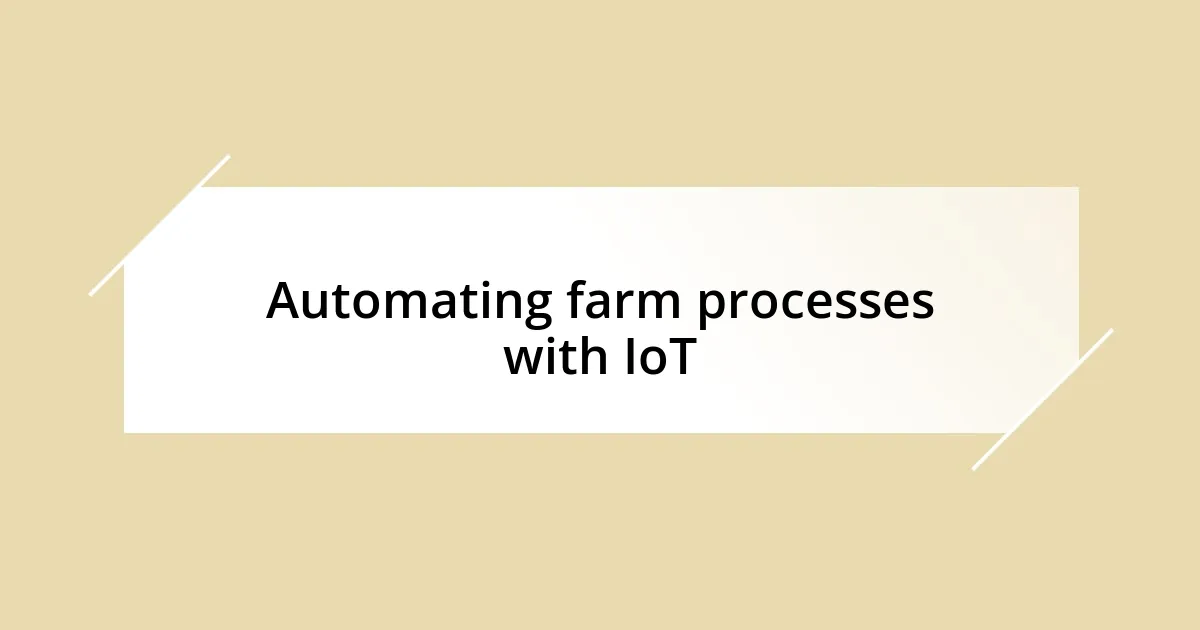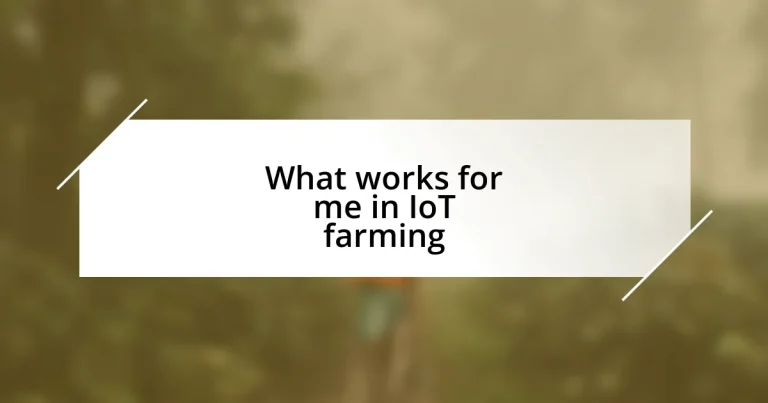Key takeaways:
- IoT in farming revolutionizes agriculture by enabling real-time monitoring of crops and resources, leading to improved efficiency and sustainability.
- Key benefits include resource efficiency, remote monitoring, and informed decision-making, enhancing farmers’ ability to manage their operations effectively.
- Automation through IoT devices like irrigation systems and drones enhances productivity and alleviates stress for farmers.
- Future trends indicate a shift towards precision agriculture and the integration of AI, promising to further optimize farming practices and sustainability.

Understanding IoT in farming
Imagine walking through a field where sensors talk to each other, sending real-time data about soil moisture, temperature, and crop health. That’s the essence of IoT in farming—a network of interconnected devices that can transform traditional agriculture into a smart, efficient operation. I remember my excitement when I first witnessed a demo of this technology; it felt like stepping into the future.
At its core, IoT in farming combines elements of technology with the age-old practice of agriculture. These devices not only monitor conditions but also provide actionable insights for farmers, helping them make informed decisions. I’ve seen firsthand how farmers use this data to optimize water usage, reducing costs and environmental impact while boosting crop yield. Isn’t it fascinating how a small sensor can hold the key to sustainability?
Moreover, the emotional impact is profound. The peace of mind that comes from knowing your crops are being monitored—even when you’re miles away—cannot be overstated. Have you ever had that nagging worry about whether your plants are thriving? With IoT technology, that worry can become a thing of the past, allowing you to focus more on innovation and less on uncertainty. It feels empowering to leverage such technology for something as vital as food production.

Benefits of IoT farming
The benefits of IoT farming are both practical and profound. One of the standout advantages is the enhanced efficiency in resource management. I vividly recall a local farmer who implemented soil moisture sensors and dramatically cut down on water usage. The sheer joy on their face when they realized they could use 30% less water while still seeing a thriving crop was contagious. It’s incredible how technology can alleviate the stress of resource allocation.
Another significant benefit lies in the ability to monitor crops remotely. I’ll never forget a conversation I had with an agronomist who shared how she could assess crop health from her smartphone while vacationing abroad. Imagine enjoying a sunny beach, knowing that sensors are actively analyzing your fields back home! This peace of mind allows for a better work-life balance, which is something we all strive for—especially in such a demanding field.
Lastly, IoT farming fosters improved decision-making through data analytics. I once attended a workshop where experts discussed how farmers could predict pest invasions by analyzing historical data patterns. It struck me how empowering this knowledge was; it transformed reactive measures into proactive strategies. Farmers can now ultimately manage risks more effectively, and that feeling of being in control—well, that’s priceless.
| Benefit | Description |
|---|---|
| Resource Efficiency | Reduces water and resource usage through real-time monitoring. |
| Remote Monitoring | Allows farmers to check crop health from anywhere, increasing peace of mind. |
| Informed Decision-Making | Utilizes data analytics for proactive farming strategies and risk management. |

Key IoT devices for farmers
When I think about the key IoT devices that have changed the landscape of farming, a few stand out prominently. For instance, I remember the first time I used a weather station that integrated IoT technology. It felt like having a personal meteorologist right in my field, providing real-time updates on weather conditions to help make critical decisions for planting. This not only improved crop yields but also saved me countless hours of worry.
Here are some essential IoT devices that farmers should consider:
- Soil Moisture Sensors: These devices provide precise soil moisture data, helping farmers irrigate more efficiently.
- Weather Stations: Minimize guesswork by delivering accurate, localized weather data directly to your smartphone or computer.
- Drone Technology: Drones equipped with cameras and sensors offer aerial views of fields, helping farmers monitor crop health and detect pests.
- Livestock Monitoring Tags: With these tags, farmers can track the health and location of their animals, ensuring better management and care.
- Automated Irrigation Systems: These systems adjust to real-time moisture levels, ensuring crops receive the right amount of water at the right time.
The emotional impact of these devices hit home for me when I saw a farmer who had installed livestock monitoring tags. He shared how they not only improved the health of his herd but also gave him peace of mind knowing he could monitor their well-being without constant physical checks. It was clear his stress had diminished, and he could devote more time to other areas of his farm—like experimenting with new crops or spending time with family. It’s moments like these that underline just how transformative these technologies can be in the agricultural world.

Connecting sensors for data collection
Connecting sensors for data collection is like creating a heartbeat for the farm. I remember the first time I set up a network of temperature and humidity sensors across my fields. The data flowed in real-time, and it felt as if I had my finger on the pulse of the crops. I could anticipate pest issues before they became a problem, and I still marvel at how something so small can lead to such profound insights.
Each sensor serves a unique purpose, and piecing them together is like crafting a puzzle. I once installed a series of soil nutrient sensors that consistently monitored levels over time. Watching the data on my screen, I could almost feel the soil talking to me. It opened my eyes to how tailored my fertilization could be, saving money and ensuring healthier crops. This experience made me question: why wait for a problem to arise when you can prevent it with knowledge?
Sometimes, I’ll sit outside at dusk, looking at my sensor hub lighting up like a starry night. It’s a reminder of the endless possibilities in farming today. The way these sensors collect data not only enriches my understanding of the ecosystem but also shapes my daily decisions. It’s surreal to think that I can rely on hard facts rather than just instinct, and it profoundly shifts my perspective on farming’s future.

Analyzing data for better yields
Analyzing data for better yields has truly revolutionized my approach to farming. I vividly recall an instance when I decided to dive deep into data analytics after noticing a dip in my corn production. By sifting through historical data on weather patterns, soil health, and crop rotation, I could pinpoint specific trends and factors affecting my yields. It was like uncovering a hidden recipe for success, and the excitement of applying those findings to my fields was immense.
Using data analytics not only empowers me to anticipate issues but also allows for timely interventions. Last summer, for example, my analysis of moisture levels indicated that one of my fields was susceptible to drought stress. I implemented additional irrigation on that section alone based on data insights. The joy I felt when that field yielded a bountiful harvest compared to the others reaffirmed my belief in the power of data-driven decisions. Have you ever wished you could predict outcomes like that? I certainly have, and now, I can.
Moreover, sharing data insights with fellow farmers creates a sense of camaraderie. When I met with a group of local farmers last fall, we exchanged our findings on fertilizer applications based on soil data. Observing their surprised expressions when they realized the potential for increased profits through simple adjustments was heartening. It’s moments like these that highlight the communal journey we’re on, leveraging technology to not just improve yields but to foster a supportive farming community. Isn’t it fascinating how something as seemingly technical as data can cultivate genuine connections?

Automating farm processes with IoT
Automating farm processes with IoT has truly changed the way I operate my farm. I remember the exhilaration I felt when I installed an automated irrigation system that responded to real-time moisture data. Just imagine being able to adjust water flow from my phone while I’m sitting in a coffee shop! It’s incredible how such technology gives me flexibility, ensuring crops receive exactly what they need without wasting resources.
On one occasion, I had to be away for a family event during a particularly dry spell. It was a leap of faith to trust the system, but I watched as it adapted to daily weather changes, managing the irrigation perfectly while I was gone. The relief washing over me when I returned to see thriving fields rather than wilting plants was profound. How many of us would feel that kind of anxiety? I can tell you from experience, there’s nothing like knowing technology has your back.
Another aspect of automation I cherish is the integration of drones for crop monitoring. The first time I flew one over my property, I felt like I was in a sci-fi movie, peering down at my crops from above. The instant visual feedback on plant health was mesmerizing and gave me insights I’d never have gained from the ground. I’m curious—what areas are you exploring in your agricultural processes? The potential for automation isn’t just an enhancement for efficiency; it’s a transformative journey I’m excited to be a part of, and I hope you are too.

Future trends in IoT farming
Looking to the future, I see a rising trend in precision agriculture enabled by IoT technology. Just the other day, while chatting with a fellow farmer, we discussed how deploying sensors that map soil nutrients can completely alter our planting strategies. Imagine having such granular insights that you know exactly where to plant specific seeds based on their unique needs—it’s like being handed a cheat sheet for successful farming.
Another exciting trend is the increased use of AI and machine learning in IoT farming. There’s something exhilarating about the idea of machines learning from the vast amounts of data we generate. Not long ago, I implemented a predictive analytics tool that analyzed weather forecasts and historical crop yields. The results blew my mind! This tool suggested planting schedules that I would never have considered, and it led to my best harvest yet. Have you ever thought about how much we could improve just by letting technology help us think differently?
Moreover, sustainability will become front and center. Integrating IoT with renewable energy sources, like solar panels, could change the game. I sometimes fantasize about a day when my entire farm runs on self-sufficient energy, powered by the sun, while my IoT devices monitor everything from crop health to resource use in real time. It’s not just about efficiency; it’s about leaving a better earth for future generations. I wonder, how cool would it be to pass down a thriving, eco-friendly farm to the next generation? Just a thought to ponder as we venture into this bright, technology-driven future.














